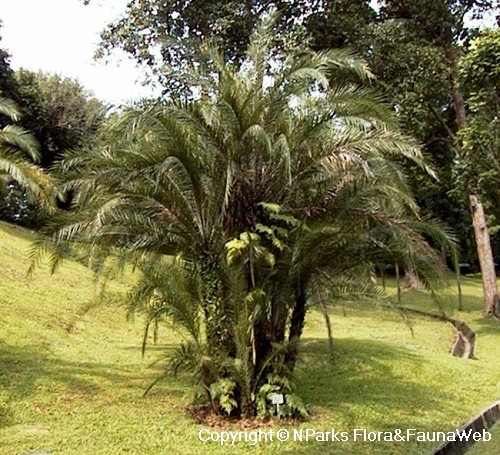
Back
Phoenix reclinata
| Family Name: | Arecaceae (Palmae) |
| Synonyms: | Phoenix spinosa |
| Common Name: | African Wild Date, Senegal Date Palm |
Name
Classifications and Characteristics
| Plant Division | Angiosperms (Flowering Seed Plants) |
|---|---|
| Plant Growth Form | Palm (Clustered Habit) |
| Maximum Height | 12 m |
Biogeography
| Native Distribution | Africa & Madagascar |
|---|---|
| Native Habitat | Terrestrial |
Description and Ethnobotany
| Growth Form | It is a clustering palm, up to 12 m tall, and often forming thicket. Cut stem produce clear yellowish sticky substance. Leaf sheath is persistent 1 – 2 m below crown. |
|---|---|
| Foliage | Leaves are arching (2 – 3.5 m long) with reddish-brown fibrous leaf sheath and comprises of 80 – 130 leaflets on each side (28 – 45 cm long and 2.2 – 3.6 cm wide). Leaflets near the base are modified into spines (3 – 9 cm long) and are irregularly arranged. |
| Flowers | The bracts enveloping the male and female inflorescence are green-yellow and split open 1 or 2 times between margins when mature. The male inflorescence is erect (17 – 30 cm long) and comprises of cream-white male flowers crowded on the stalk. Female inflorescence is erect (about 60 cm long) but slowly becomes pendulous as fruits are developed. |
| Fruit | Fruit is ovoid, and matures yellow – orange (1.3 – 2 cm long and 0.7 – 1.3 cm wide) with sweet flesh (about 0.1 – 0. 2 cm thick). Seed is obovoid with rounded tip ( 1.2 – 1.4 cm long and 0.5 cm wide). |
| Habitat | It is found in moist forest, rocky hillsides and grasslands, up to 3000 m altitude. |
| Cultivation | A wet trunk and wet soil encourage disease. |
| Ethnobotanical Uses | Edible Plant Parts : Edible Fruits Food (Fruit or Vegetable) Others: Trunks are used as beams and poles in construction. The leaf rachis is used for making thatch, floor mats and fish traps. Leaflets from young shoot are harvested for weaving baskets. The fruits are eaten as a snack and the seeds can be dried and ground into flour. The seeds can also be roasted and used as a substitute for coffee. The palm heart and flower buds are occasionally eaten as a vegetable. In South Africa, villagers harvest the sap and process it into palm wine. |
Landscaping Features
| Landscape Uses | Parks & Gardens |
|---|
Plant Care and Propagation
| Light Preference | Full Sun |
|---|---|
| Water Preference | Moderate Water |
| Plant Growth Rate | Moderate |
| Rootzone Tolerance | Well-Drained Soils |
Foliar
| Mature Foliage Colour(s) | Green |
|---|---|
| Leaf Area Index (LAI) for Green Plot Ratio | 4.0 (Palm - Cluster) |
Non - Foliar and Storage
| Trunk Type (Palm) | Clustering Habit, Aboveground |
|---|
Fruit, Seed and Spore
| Mature Fruit Colour(s) | Orange, Yellow / Golden |
|---|
Image Repository
Others
| Master ID | 1371 |
|---|---|
| Species ID | 2664 |
| Flora Disclaimer | The information in this website has been compiled from reliable sources, such as reference works on medicinal plants. It is not a substitute for medical advice or treatment and NParks does not purport to provide any medical advice. Readers should always consult his/her physician before using or consuming a plant for medicinal purposes. |



